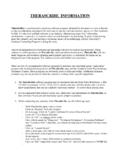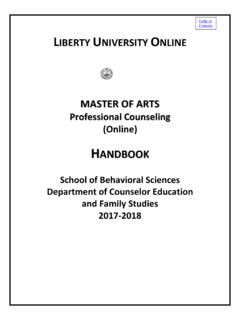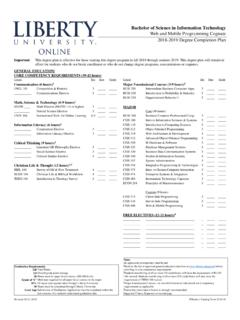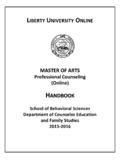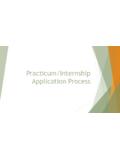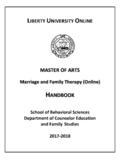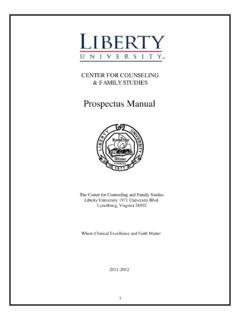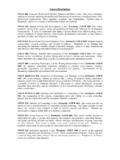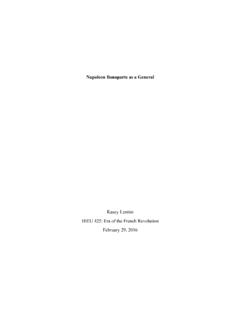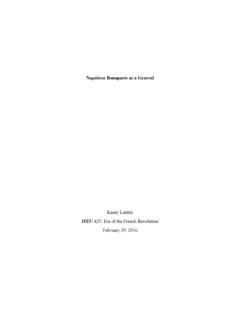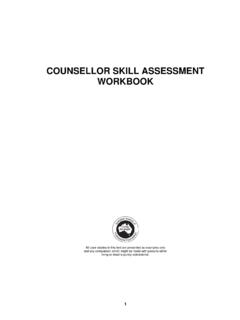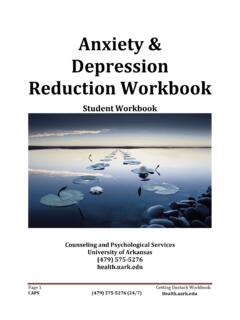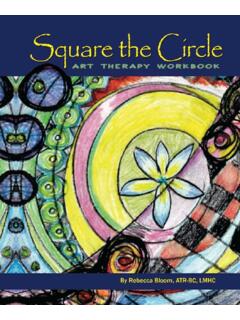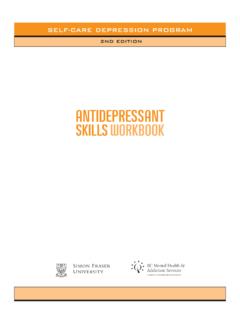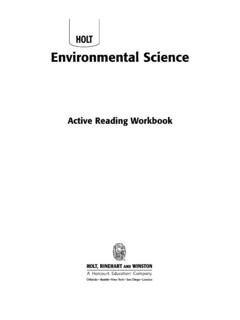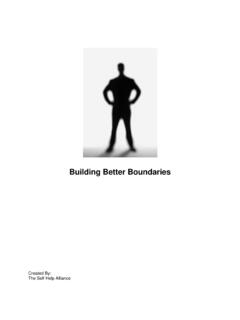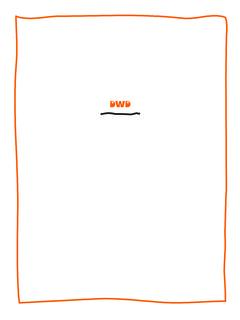Transcription of Anxiety Toolbox Student Workbook - Liberty University
1 Anxiety Toolbox Student Workbook (434) 582-2651 Green Hall January 2017 2 This Anxiety Toolbox workshop curriculum is based on the Anxiety Toolbox curriculum at Counseling Services of California Polytechnic State University , San Luis Obispo, with modifications by the Broene Counseling Center of Calvin College. Used by permission. Table of Contents Welcome Frequently Asked Questions Session 1: Anxiety 101 Stress versus Anxiety .. Understanding Anxiety Disorders .. Stress Curve .. Anxiety -Avoidance Roller Coaster .. Threat System (Fight or Flight) .. Common Anxiety Symptoms .. Feelings Wheel .. Cross Sectional Formulation (example) .. Cross Sectional Formulation (blank) .. Breathing Exercises .. Sleep Hygiene .. Homework Assignment .. Cross Sectional Formulation (blank) .. Session 2: Automatic Thoughts & Unhelpful Cognitions Cross Sectional Formulation (example).
2 Unhelpful Thinking Styles .. Identifying Triggers Worksheet .. Homework Assignment .. Identifying Triggers Worksheet .. Cross Sectional Formulation (blank) .. Session 3: Alternative Responses, Grounding, & Self-Care Alternative Response Worksheet (example) .. If You re Having Trouble .. Alternative Response Worksheet (blank) .. Grounding Exercises .. Pleasant Activities .. My Plan for Managing Anxiety .. Resources 6 7 8 8 9 10 11 12 13 14 15 16 17 21 22 23 24 25 27 31 32 34 37 39 40 3 Welcome! Welcome to Anxiety Toolbox , a fast-paced, 3-session workshop intended to help increase your understanding and knowledge about Anxiety . The goal is to provide you with some skills to recognize and manage symptoms you may be experiencing. We hope you find it helpful. The goal of this workshop is to provide you with life-long tools you can use while facing Anxiety -triggering situations.
3 Remember, this intervention is not intended to get rid of your Anxiety . While occasionally unpleasant, some Anxiety can actually be a helpful and motivating emotion. Our hope is that these three sessions provide you with a jumping board from which to integrate skills into your daily life in the service of reducing Anxiety . By the end of this course, you will have received a lot of information, and at times it may feel overwhelming. Remember that like any skill ( , learning to ride a bike), the skills you will learn in Anxiety Toolbox take time and practice to master. At times, you may encounter obstacles and/or find it difficult to integrate these skills into your daily life. That s okay it s how change works. And as with all change, it s important to practice as much as you can, even after encountering setbacks. Think of your practice of these skills as a form of mental health hygiene.
4 At the outset, it may seem tedious and you may question why you need to practice these skills so often. Think of it like dental hygiene you brush your teeth multiple times a day to prevent the buildup of plaque and ultimately to prevent cavities. Similar to brushing your teeth, daily practice prevents a buildup of Anxiety and stress over time. The more you practice and use these skills as part of your daily routine, the less tedious they may seem because they simply become a regular part of daily life. A few guidelines to keep in This workshop is confidential. Do not share information about anyone in theworkshop with others, including others stories (even if you think no one will knowwhom you re speaking about). We want to ensure that it feels safe to speak here. You are expected to attend all three sessions, as they build upon each other. If youmiss a session, you will be asked to switch to a different section of the workshop inorder to continue with the material in the proper order.
5 Please be sure to let your workshop leader know (or call the counseling office)ahead of time if you are unable to attend a at any time you feel that you need additional support, please let your workshop leader know or contact Student Counseling Services at 434-582-2651. You can also find additional resources online at re gl ad you re here! 4 Frequently Asked Questions What is Anxiety Toolbox ? Anxiety Toolbox is a fast-paced, 3-session workshop specifically designed to help people who struggle with a variety of Anxiety -related concerns ( , panic attacks, Generalized Anxiety , test Anxiety ). The goal of this workshop is to provide education on Anxiety and to teach coping skills for managing Anxiety symptoms. Why does Anxiety Toolbox use a 3-session model? Teaching Anxiety Toolbox over the course of 3 sessions allows you sufficient time to learn the concepts, with time to practice between sessions.
6 Keeping it to three 50-minute sessions allows you to find time in your busy schedule to learn these skills . What if I need more than 3 weeks to learn the model? You are not alone. The skills taught in Anxiety Toolbox are difficult and take time to build. For this reason, we offer multiple other groups, workshops, and resources that are intended to provide further support for practicing these skills . For more information, talk with your Anxiety Toolbox workshop leader or contact Student Counseling Services. What if I don t feel comfortable in groups? Many people feel a little anxious about participating in a group. Anxiety Toolbox is structured and curriculum-driven, like an academic class. You are not required to speak to the entire group if you do not feel comfortable doing so. The facilitators respect each participant s right to share only what they are comfortable sharing and never require you to share sensitive or potentially embarrassing information about yourself.
7 What if I have an urgent need to see a counselor during Anxiety Toolbox ? Simply let the workshop leader or the Student Counseling Services front desk staff know, and they will facilitate you getting the support you need. Why do I have to do homework? The focus of this workshop is on building skills to cope with Anxiety . In order to achieve that goal, regular practice is essential. The more you practice, the more you may find you get out of this workshop. The assignments are for you and only you, in the service of your own personal growth. You will not be required to provide your responses at any time during this workshop. However, it s important to bring your responses as you may be asked to look back on or elaborate on a prior assignment during the workshop. What if I didn t do my homework? We encourage you to come to group regardless of whether or not you were able to complete the homework assignment.
8 We can also assist you in working on examples when the homework is reviewed. 5 SESSION ONE Anxiety 101 6 Stress versus Anxiety Everyday Anxiety (Stress) Anxiety Disorder In response to a known environmental factor In response to an unknown source or in response to the experience of stress Symptoms go away when the stressor goes away Symptoms remain despite no identifiable stressor Worry about living away from home for the first time, passing a class, a romantic breakup, or other important life events Constant and unsubstantiated worry that causes significant distress and interferes with your daily life Embarrassment or self-consciousness in an uncomfortable or awkward social situation; feeling nervous about meeting new people Avoidance of social situations due to fear of being judged, embarrassed, or humiliated Feeling nervous or sweating before a big test, class presentation, stage performance, or other significant event Panic attacks that seem out of the blue and preoccupation with the fear of having another one Realistic fear of a dangerous object, place, or situation ( fear of poisonous snakes) Irrational fear or avoidance of an object, place, or situation that poses little or no threat of danger ( fear of elevators) Making sure that you are healthy and living in a safe environment Performing uncontrollable repetitive actions, such as excessive cleaning, checking, touching or arranging Adapted from.
9 7 Understanding Anxiety Disorders While Anxiety is a normal and adaptive experience for everyone, Anxiety disorders are characterized by significant distress or impairment in social, academic/occupational, or other important areas of functioning ( , your general ability to function in life). Some of the most common Anxiety disorders include: Generalized Anxiety Disorder: Chronic and unrealistic worry that feels difficult to control about everyday things ( , things that do not worry most people) Social Anxiety Disorder: Chronic worry solely related to social situations Panic Disorder: Characterized by episodes of panic that include things like: adrenaline surge, fear of losing control, chest pain, racing heart, shortness of breath, dizziness Phobias: Specific fears that are excessive in nature and often lead to avoiding that which is feared ( , public speaking, heights, tunnels, etc.)
10 Obsessive-Compulsive Disorder: Excessive rumination (thinking) with repetitive behaviors to reduce Anxiety 8 Yerkes Dodson Model of Stress Arousal & Performance Anxiety - Avoidance Roller Coaster Adapted from- 9 10 Common Anxiety Symptoms Physical Symptoms Increased heart rate Shortness of breath Chest pain or pressure Choking sensation Dizziness, lightheadedness Sweating, hot flashes, chills Nausea, upset stomach, diarrhea Trembling, shaking Weakness, unsteadiness, faintness Tense muscles, rigidity Dry mouth Other: _____ Behavioral Symptoms Avoidance of threat cues or situations Escape, flight Pursuit of safety, reassurance Restlessness, agitation, pacing Hyperventilation Freezing, motionlessness Difficulty speaking Other:_____ Cognitive Symptoms Fear of losing control, being unable to cope Fear of physical injury or death Fear of going crazy Fear of negative evaluations by others Frightening thoughts, images, or memories Perceptions of unreality or detachment Poor concentration, confusion, distractibility Narrowing of attention, hypervigilance for threat Poor memory Difficulty in reasoning, loss of objectivity Other:_____ Emotional Symptoms Feeling nervous, tense, wound up Feeling frightened, fearful, terrified Being edgy, jumpy, jittery Being impatient, frustrated Other: _____ Adapted from The Anxiety and Worry Workbook by Clark and Beck 11 Feelings Wheel 12 Cross Sectional Formulation (example entry) Situation (When?)
